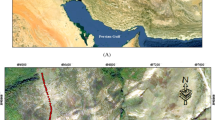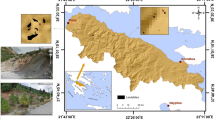Abstract
There are many parameters influencing mining induced surface subsidence. These parameters usually interact with one another and some of them have the characteristic of fuzziness. Current approaches to predicting the subsidence cannot take into account of such interactions and fuzziness. In order to overcome this disadvantage, many mining induced surface subsidence cases were accumulated, and an artificial neuro fuzzy inference system(ANFIS) was used to set up 4 ANFIS models to predict the rise angle, dip angle, center angle and the maximum subsidence, respectively. The fitting and generalization prediction capabilities of the models were tested. The test results show that the models have very good fitting and generalization prediction capabilities and the approach can be applied to predict the mining induced surface subsidence.
Similar content being viewed by others
References
JI Wan-bin. Subsidence and muildings [M]. Beijing: Seismological Press, 1998. (in Chinese)
HOU Chang-xiang, FENG Tao, XIONG Ren-qin. Deposits: mining under buildings, traffic roads and water body and on confined aquifer[M]. Beijing: China Coal Industry Press, 2001. (in Chinese)
WANG Jin-zhuang, HONG Du. Strata and surface in mines [M]. Beijing: China Coal Industry Press, 1988. (in Chinese)
WANG Shu-yuan. Methods for predicting movement of strata and surface [M]. Beijing: China Coal Industry Press, 1987. (in Chinese)
DING De-xin. Intelligence based back analysis of displacements for elastoplastic parameters of rock mass and its application[D]. Shanghai: Tongji University, 2000. (in Chinese)
YIN Guang-zhi, DAI Gao-fei, WAN Ling. Numerical simulation of strata movement behavior in deep excavation[J]. Journal of Chongqing University: Natural Science Edition, 2001, 24(5): 62–65. (in Chinese)
HONG Du. Monitoring data processing of the similar material model of strata movement [C]// National Conference of Mine Survey. 1984. (in Chinese)
DING De-xin. An orthogonal inversion approach to determining the stiff and strength parameters of rock surrounding the underground stope[J]. China Mining Magazine, 1998, 7(6): 47–50. (in Chinese)
DING De-xin, Bi Zhong-wei, Wang Wei-hua. Studies of an artificial neural network approach to predicting mining Induced surface subsidence[J]. Journal of Nanhua University, 2003, 16(3): 1–5. (in Chinese)
ZHANG Zhi-jun, DING De-xin. A comparision study of the fitting and generalization prediction capabilities of ANN and ANFIS[J]. Journal of Nanhua University, 2003, 17(4): 1–7. (in Chinese)
DING De-xin. An investigation into roof stability control in Xiangxi gold mine[J]. Journal of Hengyang Institute of Technology, 1994, 8(1): 1–3. (in Chinese)
HOU Chang-xiang. A study on relationship between overburden property and direction of influence propagation[J]. J Xiangtan Min Inst, 1999, 14(2): 20–24. (in Chinese)
LIAN Ming, WANG Cheng-xu. Prediction of mining subsidence in mountain area overlaid with thick loess bed[J]. Coal Geology & Exploration, 2001, 29(2): 44–47. (in Chinese)
WANG Jin-zhuang, LI Yong-shu, ZHOU Xiong. Ground movement caused by mining under thick alluvium[J]. Journal of China Coal Society, 1997, 22(1): 18–21. (in Chinese)
GU Shao-hua, SHI Shi-zhang. The characteristic of surface movement caused by striping with large width under buildings [J]. Coal Science & Technology, 1997, 25(9): 10–12. (in Chinese)
LI Feng-ming. The characteristics of the strata movement angles for mining under thick alluvial layer[J]. Coal Mining, 1996, 22(3): 28–30. (in Chinese)
MA Chao, HE Wan-long, KANG Ji-rong. Prediction and analysis of the area of the subsidence caused by coal mining[J]. Mine Survey, 1999(1): 16–20. (in Chinese)
ZHAO Yang-sheng. Application of finite element in mining engineering [M]. Beijing: China Coal Industry Press, 1994. (in Chinese)
YAN Rong-gui. Cataclysm and harness of public structures in the subsidence area in hilly Mine field [J]. Jiangxi Nonferrous Metal, 1999(2): 1–6. (in Chinese)
XIE He-ping, ZHOU Hong-wei, WANG Jin-an. Application of FLAC to predict ground surface displacements due to coal extraction and its comparative analysis[J]. China Journal of Rock Mechanics and Engineering, 1999, 18(4): 397–401. (in Chinese)
China University of Mining and Technology, Fuxin Institute of Mining and technology, Jiaozuo Institute of Mining and technology. Movement of strata and surface in coal mine field [M]. Beijing: China Coal Industry Press, 1985. (in Chinese)
WEN Xin, ZHOU Lu, LI Dong-jiang. Analysis and application of fuzzy logic in MATLAB tool box[M]. Beijing: Science Press, 2000. (in Chinese)
LOU Shun-tian, HU Chang-hua. Fuzzy system analysis and design based MATLAB[M]. Xi’an: Xidian University Press, 2001. (in Chinese)
Author information
Authors and Affiliations
Corresponding author
Additional information
Foundation item: Project(50274043) supported by the National Natural Science Foundation of China; project (01JJY1004) supported by the Natural Science Foundation of Hunan Province; project (01A015) supported by the Natural Science Foundation of Hunan Provincial Education Committee
Rights and permissions
About this article
Cite this article
Ding, Dx., Zhang, Zj. & Bi, Zw. A new approach to predicting mining induced surface subsidence. J Cent. South Univ. Technol. 13, 438–444 (2006). https://doi.org/10.1007/s11771-006-0064-y
Received:
Accepted:
Issue Date:
DOI: https://doi.org/10.1007/s11771-006-0064-y
Key words
- mining induced surface subsidence
- fuzziness and interaction of parameters
- artificial neural fuzzy inference system




